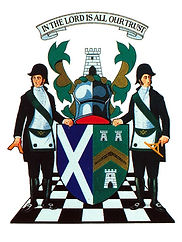
Lodge Elgin
1562 SC

Welcome!
Lodge Elgin is located in Montego Bay, Jamaica. The Lodge was chartered in August 1959 and in its rich 55 year history has always lived up to it's aim of 'making good men better'.
Meeting Info
Lodge Elgin meets on the 1st Wednesday of each month at 2 Davis Avenue, Montego Bay. Starting time: 7pm
NB* Lodge holidays: July & August
The Elgin Tartan 1562 SC
Lodge Elgin has always adorned it's masons with a special, non-standard regalia bearing the pleasing crimson plaid of the Elgin Tartan.
The Tartan speaks to our proud heritage as a Lodge aligned to The Grand Lodge of Scotland (Scottish Constitution). In general terms the 'tartan' refers to a pattern consisting of criss-crossed horizontal and vertical bands in multiple colours. Tartans originated in woven wool, but now they are made in many other materials. Tartan is particularly associated with Scotland. Scottish kilts almost always have tartan patterns.
Tartan is often called plaid in this hemispere, but in Scotland, a plaid is a tartan cloth slung over the shoulder as a kilt accessory, or a plain ordinary blanket such as one would have on a bed. The tartan has an ancient history. The earliest known tartan in Scotland can be dated to the third or fourth century AD. In other parts of the world, tartan cloth has been found dating to approximately 3000 BC. Virtually everywhere there was woven cloth, people created tartan designs. Yet only in Scotland were they given such cultural significance.
Originally, tartan designs had no names, and no symbolic meaning. All tartan cloth was hand woven, and usually supplied locally. While it may have been true that certain colors or pattern motifs were more common in some areas than others, no regulated or defined "clan tartan" system ever existed. Tartan, in general, however came to be extremely popular in Scottish Highland culture. So much so that by the seventeenth and eighteenth centuries, tartan clothing is seen to be characteristic of Highland dress.
Until the middle of the nineteenth century, the highland tartans were only associated with either regions or districts, rather than any specific Scottish clan. This was because like other materials tartan designs were produced by local weavers for local tastes and would usually only use the natural dyes available in that area, as chemical dye production was non-existent and transportation of other dye materials across long distances was prohibitively expensive. Overtime they have become linked to the region of most popular origin and effectively became a mark of identification for specific highland clans. Though clan tartans are the most well known, tartans can represent many different things. Some tartans represent families, towns, district, corporations, individuals, events
The Elgan Tartan we use today represented the unique clan tartan for Clan Elgin in the line of Clan Bruce in from Kincardine in Scotland.